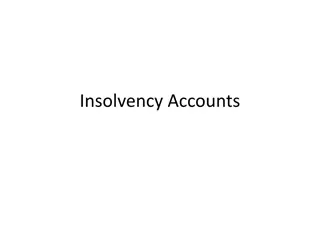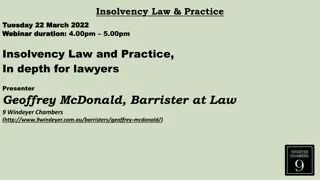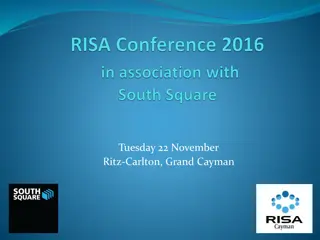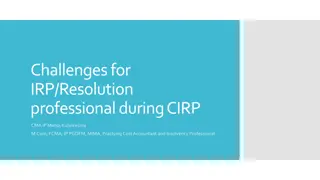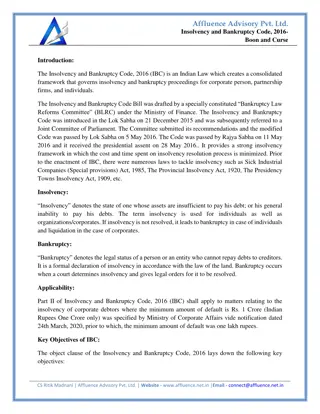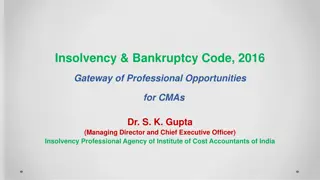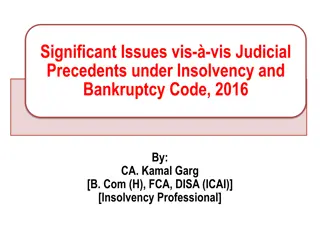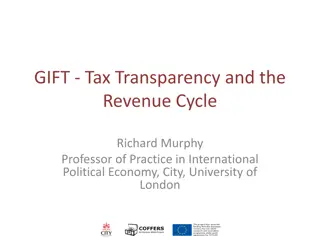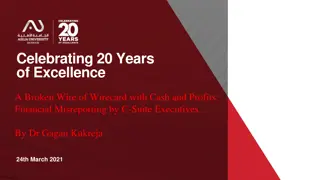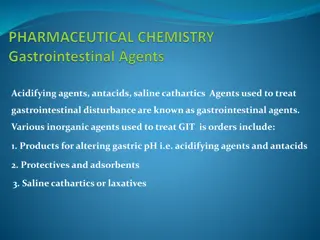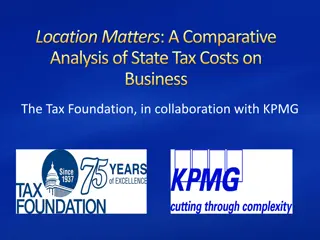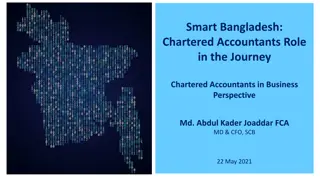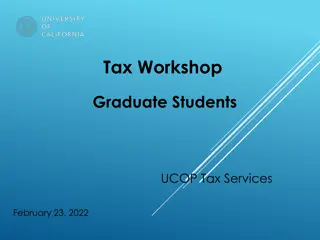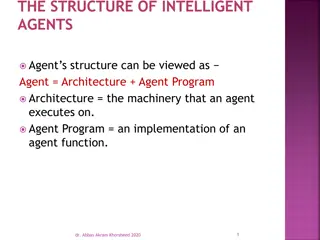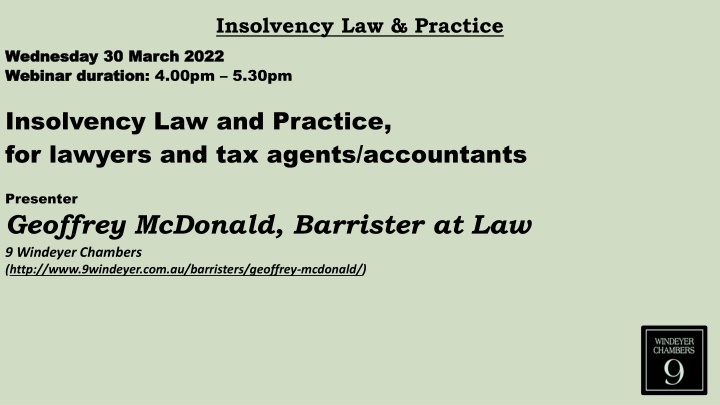
Insolvency Law and Practice Webinar - Important Topics Covered
Join the Insolvency Law and Practice webinar on Wednesday, 30th March 2022, conducted by Geoffrey McDonald, an experienced Barrister. Explore topics such as Insolvency and Taxes, Statutory Demands, Small Business Restructuring, Insolvent Trading, and more. Disclaimer: The presentation is not legal advice. Visit the website for more information.
Download Presentation

Please find below an Image/Link to download the presentation.
The content on the website is provided AS IS for your information and personal use only. It may not be sold, licensed, or shared on other websites without obtaining consent from the author. If you encounter any issues during the download, it is possible that the publisher has removed the file from their server.
You are allowed to download the files provided on this website for personal or commercial use, subject to the condition that they are used lawfully. All files are the property of their respective owners.
The content on the website is provided AS IS for your information and personal use only. It may not be sold, licensed, or shared on other websites without obtaining consent from the author.
E N D
Presentation Transcript
Insolvency Law & Practice Wednesday 30 March 2022 Wednesday 30 March 2022 Webinar duration Webinar duration: 4.00pm 5.30pm Insolvency Law and Practice, for lawyers and tax agents/accountants Presenter Geoffrey McDonald, Barrister at Law 9 Windeyer Chambers (http://www.9windeyer.com.au/barristers/geoffrey-mcdonald/)
Insolvency Laws The Presenter s background; Geoffrey McDonald The Presenter s background; Geoffrey McDonald Insolvency Accountant Insolvency Accountant 1987 became a partner, 1987 became a partner, the youngest ever of an accounting firm, aged 23 the youngest ever of an accounting firm, aged 23 1988 became a registered liquidator, then also registered as an auditor, tax agent and 1988 became a registered liquidator, then also registered as an auditor, tax agent and then Trustee in bankruptcy then Trustee in bankruptcy I went to the Bar in the late 1990s. I went to the Bar in the late 1990s. I was told that I was the I was told that I was the first person to be granted a Practicing certificate as a first person to be granted a Practicing certificate as a barrister whilst also practicing as an accountant barrister whilst also practicing as an accountant. . I soon became National Chairman of Hall Chadwick. I soon became National Chairman of Hall Chadwick. Left accounting to practise as Counsel in 2008. Left accounting to practise as Counsel in 2008. As Albert Einstein once said; As Albert Einstein once said; the fate of the old one, recognises the culture of the young the fate of the old one, recognises the culture of the young NEXT SEMINAR FOR ACCOUNTANTS; MAY 5 NEXT SEMINAR FOR ACCOUNTANTS; MAY 5TH TH2022 (FACE 2022 (FACE- -TO TO- -FACE) FACE)
Insolvency Law & Practice Disclaimer; Disclaimer; this presentation and these papers are not legal advice! this presentation and these papers are not legal advice! Web site for Papers: https://www.9windeyer.com.au/barristers/geoffrey-mcdonald/ Past papers by Geoffrey McDonald: link at List.docx (google.com) Due to the relatively short duration of this Webinar, you will find that the presentation will bring Due to the relatively short duration of this Webinar, you will find that the presentation will bring issues to your attention, rather than answer all the questions and the PowerPoint paper and the issues to your attention, rather than answer all the questions and the PowerPoint paper and the Webinar Video will be a helpful resource for future guidance (both soon to be posted on the 9 Webinar Video will be a helpful resource for future guidance (both soon to be posted on the 9 Windeyer Website). Windeyer Website). You are invited to ask questions You are invited to ask questions after the Webinar after the Webinar by emailing gmcdonald@windeyerchambers.com.au gmcdonald@windeyerchambers.com.au by emailing
Insolvency Law & Practice Outline; 1. 2. 3. 4. 5. 6. 7. 8. 9. 10. 11. 12. 13. 14. Insolvency and Taxes Statutory Demands, Bankruptcy Notices and Court actions Books and records Small Business Restructuring Plans/Practitioners/Proposals and Simplified Liquidations Insolvent trading safe harbour accountants/advisors role High Court - Liquidator examinations High Court Asset based lending and Accountants/Solicitors Certificates Phoenix Companies Accountants and solicitor s role Untrustworthy Advisors AFSA focus Director resignations Director Penalty Notices Conflict of Interest Director related transactions Other changes
Insolvency Law & Practice 1. Insolvency and Taxes Total personal insolvencies fell by 49.6% in 2020 21 compared to 2019 20. By type of personal insolvency: bankruptcies fell by 46.7% debt agreements fell by 54.2% personal insolvency agreements fell by 46.7% (there were 89 personal insolvency agreements in Australia in 2020 21) https://www.afsa.gov.au/about-us/statistics Annual statistics for 2020 21 Companies entering external administration and controller appointments 2019-2020 10,063 2020-2021 6,027 (SBRP 12, Plans 6)(Simp Liq 23) https://asic.gov.au/regulatory-resources/find-a-document/statistics/insolvency-statistics/insolvency-statistics-series-2-external-administration-and-controller-appointments/
Insolvency Law & Practice 1. Insolvency and Taxes It has also been reported that the It has also been reported that the Australian Taxation Office's (ATO) business debt Australian Taxation Office's (ATO) business debt has doubled from $24.9 billion (30 June 2020) to a colossal from $24.9 billion (30 June 2020) to a colossal $53.8 billion (30 June 2021) $53.8 billion (30 June 2021), with that data being nine months old. nine months old. has doubled , with that data being Typically, the ATO applies to wind up an average 100 companies a month, but applications Typically, the ATO applies to wind up an average 100 companies a month, but applications were abandoned during the COVID were abandoned during the COVID- -19 period. 19 period. The Australian Tax Office has resumed chasing debts in Victoria, New South Wales and the The Australian Tax Office has resumed chasing debts in Victoria, New South Wales and the ACT following a temporary pause as residents braved COVID ACT following a temporary pause as residents braved COVID- -19 lockdowns. 19 lockdowns. In a statement to In a statement to 7NEWS.com.au resumed with penalties for non resumed with penalties for non- -compliance expected to be more noticeable in the three compliance expected to be more noticeable in the three jurisdictions. jurisdictions. Nov 2021 7NEWS.com.au, an ATO spokesperson confirmed all enforcement actions had , an ATO spokesperson confirmed all enforcement actions had Posted on 2/12/2021 ARITA has published an information sheet for members facing financial distress
Insolvency Laws 2. 2. Statutory Demands, Bankruptcy Notices and Court actions For the For the period from 24 March 2020, to 31 December 2020 period from 24 March 2020, to 31 December 2020, the insolvency laws were changed to; Increase the current minimum threshold for creditors issuing a Increase the current minimum threshold for creditors issuing a statutory demand company under the Corporations Act 2001 from $2,000 to $ company under the Corporations Act 2001 from $2,000 to $20,000 Extend the statutory timeframe for a company to respond to a statutory demand from 21 days Extend the statutory timeframe for a company to respond to a statutory demand from 21 days to to six months six months. . Increase the threshold for the minimum amount of debt required for a creditor to Increase the threshold for the minimum amount of debt required for a creditor to initiate bankruptcy proceedings bankruptcy proceedings from its current level of $5,000 to $20,000. from its current level of $5,000 to $20,000. Increase the time a debtor has to respond to a Increase the time a debtor has to respond to a bankruptcy notice Corporations Amendment (Corporate Insolvency Reforms) Act 2020 Corporations Amendment (Corporate Insolvency Reforms) Act 2020 Extended in September 2020 to 31 December 2021 Extended in September 2020 to 31 December 2021 , the insolvency laws were changed to; statutory demand on a 20,000. . on a initiate bankruptcy notice from 21 days to from 21 days to six months six months. .
Insolvency Laws 2 2 Statutory Demands, Bankruptcy Notices and Court actions The threshold for a creditor to issue a statutory demand is $4,000, as from 1 July 2021. The threshold for a creditor to issue Bankruptcy Notice is $10,000, as from 1 January 2021 (also Creditor s Petition) s. 44 Conditions on which creditor may petition s. 44 Conditions on which creditor may petition (1) A creditor's petition shall not be presented against a debtor unless: (1) A creditor's petition shall not be presented against a debtor unless: (a) there is owing by the debtor to the petitioning creditor a debt that amounts to the statutory minimum (a) there is owing by the debtor to the petitioning creditor a debt that amounts to the statutory minimum (c) the act of bankruptcy on which the petition is founded was committed within 6 months before the presentation of the peti (c) the act of bankruptcy on which the petition is founded was committed within 6 months before the presentation of the petiti tion. on.
Insolvency Laws 2. Statutory Demands, Bankruptcy Notices and Court actions Links below Links below Bankruptcy Information Sheet 1: Presenting a creditor's petition (fedcourt.gov.au) Bankruptcy Information Sheet 2: Creditor's petition checklist (fedcourt.gov.au) Bankruptcy Information Sheet 3: Opposing a creditor's petition (fedcourt.gov.au) Bankruptcy Information Sheet 4: Setting aside a bankruptcy notice (fedcourt.gov.au) Bankruptcy Information Sheet 5: Substituted service applications (fedcourt.gov.au) Updated January 2021 Corporations Information Sheet 1: Winding up proceedings based on an unsatisfied Statutory Demand (fedcourt.gov.au) Corporations Information Sheet 2: Winding up checklist (fedcourt.gov.au) Also; https://www.afsa.gov.au/bankruptcy-by-sequestration-order
Insolvency Laws 2. Statutory Demands, Bankruptcy Notices and Court actions Pegios Pegios in his own capacity and as trustee for in his own capacity and as trustee for Pegios Pegios Superannuation Fund v Superannuation Fund v Arambasic Arambasic [2022] FedCFamC2G 17. [2022] FedCFamC2G 17. The lawyers for the creditor had emailed the bankruptcy notice to the The lawyers for the creditor had emailed the bankruptcy notice to the debtor s address and the creditor s petition was later served in the same manner. address and the creditor s petition was later served in the same manner. debtor s email email The Court referred to regulation 102 of the new Bankruptcy Regulations 2021, which The Court referred to regulation 102 of the new Bankruptcy Regulations 2021, which traces to s 28A of the Acts Interpretation Act 1901 and then to s 9 of the Electronic traces to s 28A of the Acts Interpretation Act 1901 and then to s 9 of the Electronic Transactions Act 1999. The Court found that these laws require a debtor to first Transactions Act 1999. The Court found that these laws require a debtor to first consent to be served by email. consent to be served by email. The facts in this case were that the debtor had replied by email to the creditor s The facts in this case were that the debtor had replied by email to the creditor s lawyer s email and deposed I was served with the Bankruptcy Notice which was lawyer s email and deposed I was served with the Bankruptcy Notice which was served on me on 19 May 2021 . served on me on 19 May 2021 . The Court held that her affidavit was not valid to prove service of the bankruptcy The Court held that her affidavit was not valid to prove service of the bankruptcy notice. notice.
Insolvency Laws 2. Statutory Demands, Bankruptcy Notices and Court actions ACTS INTERPRETATION ACT 1901 ACTS INTERPRETATION ACT 1901 - - SECT 28A Service of documents Service of documents (1) For the purposes of any Act that requires or permits a document to be (1) For the purposes of any Act that requires or permits a document to be served on a person, whether the expression "serve", "give" or "send" or any other served on a person, whether the expression "serve", "give" or "send" or any other expression is used, then the document may be served: expression is used, then the document may be served: (a) on a natural person: (a) on a natural person: ( (i i) ) by delivering it to the person personally; or by delivering it to the person personally; or (ii) by leaving it at, or by sending it by pre (ii) by leaving it at, or by sending it by pre- -paid post to, the address of the place of residence or business of the person last known to the person serving of the place of residence or business of the person last known to the person serving the document the document SECT 28A paid post to, the address s 9 of the Electronic Transactions Act 1999 s 9 of the Electronic Transactions Act 1999 For Companies; Corporations Act section 109X For Companies; Corporations Act section 109X
Insolvency Laws 2. Statutory Demands, Bankruptcy Notices and Court actions Samsakopoulos Samsakopoulos v Body Corporate for Sanderling at Kings Beach CTS 2942 [2021] FCAFC 143 v Body Corporate for Sanderling at Kings Beach CTS 2942 [2021] FCAFC 143 http://www.austlii.edu.au/cgi http://www.austlii.edu.au/cgi- -bin/viewdoc/au/cases/cth/FCAFC/2021/143.html bin/viewdoc/au/cases/cth/FCAFC/2021/143.html 1 November 2018, made bankrupt 1 November 2018, made bankrupt by order of the Registrar 14 April 2019, applied to review 14 April 2019, applied to review the Registrar s decision 17 July 2019, 17 July 2019, Registrar s Registrar s decision set aside and the Creditor s Petition be decision set aside and the Creditor s Petition be dismissed. dismissed. The Trustee appeared, but made no submissions regarding his costs or The Trustee appeared, but made no submissions regarding his costs or the alternative of annulment under s153B (relying on the alternative of annulment under s153B (relying on Pattison v (2006) 155 FCR 226) (2006) 155 FCR 226) http://www.austlii.edu.au/cgi http://www.austlii.edu.au/cgi- - bin/viewdoc/au/cases/cth/FCCA/2019/2133.html bin/viewdoc/au/cases/cth/FCCA/2019/2133.html 11 December 2019, Trustee applied for approval of his remuneration/costs and an 11 December 2019, Trustee applied for approval of his remuneration/costs and an order that they be paid by either the ex order that they be paid by either the ex- -bankrupt or the creditor bankrupt or the creditor 15 July 2020, the Court dismissed that application, on the basis that s.104(3) of the 15 July 2020, the Court dismissed that application, on the basis that s.104(3) of the FCCA Act was not wide enough to support the making of an order in the trustee s FCCA Act was not wide enough to support the making of an order in the trustee s favour for his remuneration, costs and expenses. favour for his remuneration, costs and expenses. http://www.austlii.edu.au/cgi bin/viewdoc/au/cases/cth/FCCA/2020/1909.html bin/viewdoc/au/cases/cth/FCCA/2020/1909.html by order of the Registrar the Registrar s decision Pattison v Hadjimouratis Hadjimouratis http://www.austlii.edu.au/cgi- - The Full Court, constituted by 5 Judges, allowed the appeal and ordered The Full Court, constituted by 5 Judges, allowed the appeal and ordered
Insolvency Laws 2. Statutory Demands, Bankruptcy Notices and Court actions ORDERS ORDERS 1. There be leave to the applicant to appeal. 1. There be leave to the applicant to appeal. 2. The appeal is allowed. 2. The appeal is allowed. 3. The orders of the Federal Circuit Court made on 11 December 2019 are set 3. The orders of the Federal Circuit Court made on 11 December 2019 are set aside and in lieu thereof it is ordered pursuant to s 104(3) of the Federal Circuit Court aside and in lieu thereof it is ordered pursuant to s 104(3) of the Federal Circuit Court of Australia Act 1999 ( of Australia Act 1999 (Cth Cth) that the following orders be made consequent upon the ) that the following orders be made consequent upon the order made by the Federal Circuit Court on 17 July 2019 that the creditor's petition order made by the Federal Circuit Court on 17 July 2019 that the creditor's petition filed on 30 July 2018 be dismissed (Dismissal Order): filed on 30 July 2018 be dismissed (Dismissal Order): (a) (a) the petitioning creditor do pay the reasonable remuneration of Mr William the petitioning creditor do pay the reasonable remuneration of Mr William Roland Robson in administering the estate of Ms Victoria Roland Robson in administering the estate of Ms Victoria Samsakopoulos the orders made by a registrar of the Federal Circuit Court exercising delegated the orders made by a registrar of the Federal Circuit Court exercising delegated judicial power (Administration) which orders ceased to have effect on 17 July 2019, judicial power (Administration) which orders ceased to have effect on 17 July 2019, such remuneration to be capped in the amount of $30,000 plus GST; such remuneration to be capped in the amount of $30,000 plus GST; (b) the petitioning creditor do pay the (b) the petitioning creditor do pay the costs and expenses costs and expenses reasonably and properly incurred by Mr Robson in the Administration prior to 17 July 2019; properly incurred by Mr Robson in the Administration prior to 17 July 2019; (c) there be (c) there be no order as to the remuneration, costs and expenses incurred by Mr no order as to the remuneration, costs and expenses incurred by Mr Robson in respect of the Administration on or after 17 July 2019 Robson in respect of the Administration on or after 17 July 2019; ; Samsakopoulos pursuant to pursuant to reasonably and
Insolvency Laws 2. Statutory Demands, Bankruptcy Notices and Court actions (h) (h) the petitioning creditor shall not by any means seek to recover any the petitioning creditor shall not by any means seek to recover any contribution from Ms contribution from Ms Samsakopoulos Samsakopoulos in respect of any amount that the petitioning in respect of any amount that the petitioning creditor is liable creditor is liable or becomes liable to pay pursuant to these orders; or becomes liable to pay pursuant to these orders; ( (i i) ) it is declared that Ms it is declared that Ms Samsakopoulos Samsakopoulos shall not have the status of a former bankrupt; bankrupt; (j) there be no orders as to the costs of the application filed on 11 December (j) there be no orders as to the costs of the application filed on 11 December 2019; and 2019; and (k) there be liberty to apply for any further consequential orders. (k) there be liberty to apply for any further consequential orders. shall not have the status of a former
Insolvency Laws 3. 3. Creditor s Petition; Set aside v Annulment (on review of Registrar Decision) 9. the applicant creditor had 9. the applicant creditor had received payment of $77.25 and no more received payment of $77.25 and no more. There is a positive deposition that positive deposition that the balance of the debt on which the applicant creditor then the balance of the debt on which the applicant creditor then relied was $5001.76 relied was $5001.76 and was then still owing and was then still owing 16. ..The first is the 16. ..The first is the applicant swears that she paid $80 off applicant swears that she paid $80 off what she says was owed and what the petitioning creditor says was owed before the sequestration order was and what the petitioning creditor says was owed before the sequestration order was made. made. That would have reduced any amount owing by her to less than the statutory That would have reduced any amount owing by her to less than the statutory minimum (to $4,998.96). minimum (to $4,998.96). 17. For reasons that again are not explained, the petitioning creditor only credits the 17. For reasons that again are not explained, the petitioning creditor only credits the applicant before me with $77.25. applicant before me with $77.25. . There is a what she says was owed 19. To the extent that the petitioning creditor seeks to rely on a greater amount now 19. To the extent that the petitioning creditor seeks to rely on a greater amount now having regard to the current account, having regard to the current account, the petitioning creditor does not discharge the the petitioning creditor does not discharge the onus of proof on it to prove on the balance of probabilities that the respondent before onus of proof on it to prove on the balance of probabilities that the respondent before me owes to the petitioning creditor an amount in excess of $5000. me owes to the petitioning creditor an amount in excess of $5000. Samsakopoulos Samsakopoulos v Body Corporate for Sanderling at Kings Beach CTS 2942 [2021] FCAFC 143 v Body Corporate for Sanderling at Kings Beach CTS 2942 [2021] FCAFC 143
Insolvency Laws 3. Books and records 136 One further matter should be mentioned concerning these minutes Section 136 One further matter should be mentioned concerning these minutes Section 251A(1) relevantly provides that 251A(1) relevantly provides that the company: the company: ... must keep minute books in which it records within 1 month: ... must keep minute books in which it records within 1 month: (a) proceedings and resolutions of meetings of the company's members; ... (a) proceedings and resolutions of meetings of the company's members; ... 137 Section 251A(6) provides that a minute that is so recorded and signed is 137 Section 251A(6) provides that a minute that is so recorded and signed is evidence of the proceeding, resolution or declaration evidence of the proceeding, resolution or declaration to which it relates, unless the contrary is proved. contrary is proved. to which it relates, unless the 138 Section 251A(6) is only engaged when there has been 138 Section 251A(6) is only engaged when there has been strict compliance requirements of s 251A(1), including that the requirements of s 251A(1), including that the minute be recorded in a minute book within one month within one month of the meeting: ASIC v Macdonald (No 11) at [70] of the meeting: ASIC v Macdonald (No 11) at [70]- -[71] ( strict compliance with the minute be recorded in a minute book with the [71] (Gzell Gzell J). J).
Insolvency Laws 3. Books and records 141 Here, the minutes of the 2002 and 2003 AGMs were exhibited to an affidavit of 141 Here, the minutes of the 2002 and 2003 AGMs were exhibited to an affidavit of Ricards Ricards, , but no evidence was given that these minutes were recorded in a minute but no evidence was given that these minutes were recorded in a minute book of the company within a month of the meeting. book of the company within a month of the meeting. Nor is there any reason to infer that this occurred. No strict compliance with s 251A(1) of the Corporations Act was that this occurred. No strict compliance with s 251A(1) of the Corporations Act was established as required: see Warner Capital Pty Ltd v established as required: see Warner Capital Pty Ltd v Shazbot 121 at [114] (Gleeson JA, 121 at [114] (Gleeson JA, Macfarlan Macfarlan and Meagher JJA agreeing). and Meagher JJA agreeing). Nor is there any reason to infer Shazbot Pty Ltd [2020] NSWCA Pty Ltd [2020] NSWCA 142 Accordingly, s 251A(6) of the Corporations Act was not engaged and the general 142 Accordingly, s 251A(6) of the Corporations Act was not engaged and the general provision in s1305(2) cannot assist the respondents: see [138] provision in s1305(2) cannot assist the respondents: see [138]- -[140] above. [140] above. Mualim Mualim v v Dzelme Dzelme [2021] NSWCA 199 (3 September 2021) [2021] NSWCA 199 (3 September 2021)
Insolvency Laws 3. Books and records 152 That is, the obligation to keep financial records under section 286 is twofold: 152 That is, the obligation to keep financial records under section 286 is twofold: first, to first, to keep records keep records which record the company's transactions and financial which record the company's transactions and financial performance sufficient to enable financial statements to be prepared; and, secondly, performance sufficient to enable financial statements to be prepared; and, secondly, to to retain those records for seven years retain those records for seven years. The records which must be . The records which must be retain simply the financial statements that were prepared from the financial records, but simply the financial statements that were prepared from the financial records, but the underlying financial records from which the financial statements were prepared. underlying financial records from which the financial statements were prepared. retained are not ed are not the 155 It is 155 It is not seeking a finding that a company has not complied with its record keeping seeking a finding that a company has not complied with its record keeping obligations. Apart from a handful of documents produced shortly before or during the obligations. Apart from a handful of documents produced shortly before or during the hearing, hearing, neither the husband or wife produced any invoices, receipts, documents of neither the husband or wife produced any invoices, receipts, documents of "prime entry" "prime entry" such as the cash book and journal, ledgers, working papers or such as the cash book and journal, ledgers, working papers or supporting source documents needed to "explain" the methods used to prepare the supporting source documents needed to "explain" the methods used to prepare the draft financial statements and any adjustments made in them draft financial statements and any adjustments made in them not clear why the liquidator is obliged to clear why the liquidator is obliged to conduct examinations conduct examinations before before
Insolvency Laws 3. Books and records 2689 Financial records are defined in s 9 to include: invoices, receipts, orders for 2689 Financial records are defined in s 9 to include: invoices, receipts, orders for the payment of money, bills of exchange, cheques, promissory notes and vouchers; the payment of money, bills of exchange, cheques, promissory notes and vouchers; documents of prime entry; and working papers and other documents needed to documents of prime entry; and working papers and other documents needed to explain the methods by which financial statements are made up; and adjustments to explain the methods by which financial statements are made up; and adjustments to be made in preparing financial statements. be made in preparing financial statements. It has been held that the records required to be kept under s 286 include a balance sheet, profit and loss statement and a cash to be kept under s 286 include a balance sheet, profit and loss statement and a cash flow statement flow statement (ASIC v ABC Fund Managers at [44]). The authors of Austin & Black (ASIC v ABC Fund Managers at [44]). The authors of Austin & Black further note that further note that the keeping of a general ledger appears to be one of the minimum the keeping of a general ledger appears to be one of the minimum requirements of this section requirements of this section (referring to Van (referring to Van Reesema 10 ACLC 291 (Van 10 ACLC 291 (Van Reesema Reesema v v Flavel Flavel) at 295; Love v ASC (2000) 36 ACSR 363; [2000] ) at 295; Love v ASC (2000) 36 ACSR 363; [2000] WASCA 404 at [59] per Owen J), WASCA 404 at [59] per Owen J), and that this requirement is not met by keeping the and that this requirement is not met by keeping the source material from which a set of books may be written up source material from which a set of books may be written up (again citing Van Reesema Reesema v v Flavel Flavel and ASIC v ABC Fund Managers). and ASIC v ABC Fund Managers). It has been held that the records required Reesema v v Flavel Flavel (1992) 7 ACSR 225; (1992) 7 ACSR 225; (again citing Van 2690 In Love v ASIC, it was said that 2690 In Love v ASIC, it was said that failure to record loan transactions and to failure to record loan transactions and to carry out proper account reconciliations provided sufficient evidence to establish carry out proper account reconciliations provided sufficient evidence to establish contravention of the section. contravention of the section. In the matters of Earth Civil Australia Pty Ltd, RCG CBD Pty Ltd, In the matters of Earth Civil Australia Pty Ltd, RCG CBD Pty Ltd, Bluemine Bluemine Pty Ltd, Pty Ltd, Diamondwish Diamondwish Pty Ltd and Pty Ltd and Rackforce Rackforce Pty Ltd (all in Pty Ltd (all in liq liq) [2021] NSWSC 966 (6 August 2021) ) [2021] NSWSC 966 (6 August 2021)
Insolvency Laws 4. Small Business Restructuring Practitioners and their Plans 4. Small Business Restructuring Practitioners and their Plans The Corporations Amendment (Corporate Insolvency Reforms) Act 2020 commenced The Corporations Amendment (Corporate Insolvency Reforms) Act 2020 commenced on 1 January 2021 and brought about significant insolvency law reforms; on 1 January 2021 and brought about significant insolvency law reforms; - - A new debt restructuring process designed to reduce complexity, time and costs. A new debt restructuring process designed to reduce complexity, time and costs. A new simplified liquidation process allows businesses to wind up faster. A new simplified liquidation process allows businesses to wind up faster.
Insolvency Laws 4. Small Business Restructuring Practitioners and their Plans 4. Small Business Restructuring Practitioners and their Plans Eligibility criteria; Eligibility criteria; Liabilities are under $1m Liabilities are under $1m, excluding employee entitlements. , excluding employee entitlements. (check for any related parties loans, third party financing facilities) (check for any related parties loans, third party financing facilities) The Company has not been subject to a simplified liquidation or SBRP in the The Company has not been subject to a simplified liquidation or SBRP in the previous 7 years. previous 7 years. Directors, including former directors acting in the preceding 12 months, have not Directors, including former directors acting in the preceding 12 months, have not been involved in a simplified liquidation been involved in a simplified liquidation or small business restructure in the previous 7 years. previous 7 years. Tax obligations are up to date Tax obligations are up to date (viz. 20 days to meet tax (viz. 20 days to meet tax lodgment lodgment obligations). obligations). Employee entitlements are up to date Employee entitlements are up to date (viz. 20 days to meet outstanding employee entitlements including super.) (viz. 20 days to meet outstanding employee entitlements including super.) or small business restructure in the
Insolvency Laws 4. Small Business Restructuring Practitioners and their Plans 4. Small Business Restructuring Practitioners and their Plans Restructuring Proposal Statement Restructuring Proposal Statement Approved Form Approved Form Corporations Act 2001, Section 455B, Corporations Regulations 2001, Reg 5.3B.16(2)(b) and Reg 5.3B.65 Corporations Act 2001, Section 455B, Corporations Regulations 2001, Reg 5.3B.16(2)(b) and Reg 5.3B.65 B. B. Important Information about restructuring plans Important Information about restructuring plans 1. 1. Deciding whether to accept a Plan Deciding whether to accept a Plan A decision about whether a restructuring plan should be accepted is made by A decision about whether a restructuring plan should be accepted is made by affected creditors who receive the following documents from a restructuring affected creditors who receive the following documents from a restructuring practitioner in relation to a company: practitioner in relation to a company: a. a. the company s restructuring plan; the company s restructuring plan; b. b. restructuring plan standard terms; restructuring plan standard terms; c. c. the company s restructuring proposal statement the company s restructuring proposal statement d. d. a declaration from the restructuring practitioner a declaration from the restructuring practitioner about whether the eligibility criteria for restructuring are met, criteria for restructuring are met, whether the company is likely to be able to whether the company is likely to be able to discharge the plan obligations discharge the plan obligations, and statements about the practitioners belief , and statements about the practitioners belief about the completeness of information set out in the company s restructuring about the completeness of information set out in the company s restructuring proposal statement proposal statement; ; about whether the eligibility
Insolvency Laws 4. Small Business Restructuring Practitioners and their Plans 4. Small Business Restructuring Practitioners and their Plans During the restructuring period, During the restructuring period, the directors remain in control the directors remain in control of the company and may enter into a transaction or dealing with company assets if it is in the ordinary may enter into a transaction or dealing with company assets if it is in the ordinary course of the company s business. course of the company s business. A plan is accepted if A plan is accepted if, at the end of 15 business days, , at the end of 15 business days, the majority in value of affected creditors creditors who returned statements to the restructuring practitioner, stated that the who returned statements to the restructuring practitioner, stated that the plan should be accepted. plan should be accepted. of the company and the majority in value of affected Companies subject to restructuring are shown as EXAD (external administration) Companies subject to restructuring are shown as EXAD (external administration) and and a company that makes a restructuring plan is shown as REGD (registered a company that makes a restructuring plan is shown as REGD (registered). This is because regulation 9.1.02(a) of the Corporations Regulations 2001 requires the is because regulation 9.1.02(a) of the Corporations Regulations 2001 requires the company register to disclose that a company is under restructuring but not when the company register to disclose that a company is under restructuring but not when the company has made a restructuring plan. company has made a restructuring plan. ). This
Insolvency Laws 4. Small Business Restructuring Practitioners and their Plans 4. Small Business Restructuring Practitioners and their Plans CORPORATIONS REGULATIONS 2001 CORPORATIONS REGULATIONS 2001 - - REG 5.3B.25 Acceptance of restructuring plan Acceptance of restructuring plan (2) For the purposes of (2) For the purposes of subregulation subregulation (1): (1): (a) the (a) the value of an affected creditor value of an affected creditor is to be worked out: ( (i i) by reference to the value of the ) by reference to the value of the creditor's admissible debts are known are known at the time the restructuring began at the time the restructuring began; or (ii) if a person is an affected creditor because the person purchased another (ii) if a person is an affected creditor because the person purchased another creditor's admissible debts or claims creditor's admissible debts or claims-- --by reference to the value of by reference to the value of the purchase price (b) where there have been mutual credits, mutual debts or other (b) where there have been mutual credits, mutual debts or other mutual dealings between the company and an affected creditor: between the company and an affected creditor: ( (i i) an account is to be taken of ) an account is to be taken of what is due from the one party to the other respect of those mutual dealings respect of those mutual dealings (c) (c) disregard an affected creditor who is an excluded creditor disregard an affected creditor who is an excluded creditor. . REG 5.3B.25 is to be worked out: creditor's admissible debts or claims that or claims that ; or the purchase price; and mutual dealings ; and what is due from the one party to the other in in
Insolvency Laws 4. Simplified Liquidation Process 4. Simplified Liquidation Process Guide; Guide; Simplified liquidation | ASIC - Australian Securities and Investments Commission Where Where a liquidator has been appointed pursuant to a creditor s voluntary liquidation a liquidator has been appointed pursuant to a creditor s voluntary liquidation and they consider on reasonable grounds that the company meets the eligibility and they consider on reasonable grounds that the company meets the eligibility criteria, criteria, the liquidator may choose to adopt the small business liquidation the liquidator may choose to adopt the small business liquidation process rather than the standard creditor s voluntary liquidation process. rather than the standard creditor s voluntary liquidation process. the liquidator is the liquidator is not required to submit a section 533 report not required to submit a section 533 report to ASIC misconduct unless there are reasonable grounds that misconduct has occurred. misconduct unless there are reasonable grounds that misconduct has occurred. the liquidator is the liquidator is not required (entitled) to hold formal creditor s meetings not required (entitled) to hold formal creditor s meetings and can instead distribute information to creditors, and proposals for voting, electronically. instead distribute information to creditors, and proposals for voting, electronically. the the unfair preference voidable transaction provisions are restricted unfair preference voidable transaction provisions are restricted to prevent the liquidator pursuing claims against unrelated entities. liquidator pursuing claims against unrelated entities. process to ASIC on potential on potential and can to prevent the
Insolvency Laws 4. Simplified Liquidation Process 4. Simplified Liquidation Process In order for a company to be In order for a company to be eligible it must satisfy a number of requirements under the legislation including: it must satisfy a number of requirements under the legislation including: The company must already be in liquidation pursuant to The company must already be in liquidation pursuant to a creditor s voluntary liquidation liquidation. . The company The company must have must have liabilities less than $1 million liabilities less than $1 million (Reg 5.503(1)) The company must have its The company must have its tax lodgements up to date tax lodgements up to date (returns, notices, statements and applications as required by taxation laws). statements and applications as required by taxation laws). Creditors Creditors (25% in value, excluding related entities [Reg 5.5.09]) may also (25% in value, excluding related entities [Reg 5.5.09]) may also request in writing that the liquidator not follow the simplified liquidation process writing that the liquidator not follow the simplified liquidation process within 20 days days of the event triggering the simplified liquidation process, and the liquidator of the event triggering the simplified liquidation process, and the liquidator must cease the simplified liquidation process if the eligibility criteria are no longer must cease the simplified liquidation process if the eligibility criteria are no longer met. (s500A(2)) met. (s500A(2)) eligible for the simplified liquidation for the simplified liquidation a creditor s voluntary (Reg 5.503(1)). . (returns, notices, request in within 20
Insolvency Laws 5. Insolvent Trading 5. Insolvent Trading As we have previously highlighted, As we have previously highlighted, safe harbour company enters. It is a company enters. It is a set of actions set of actions which may insolvent trading liabilities insolvent trading liabilities in the event the company ends up in liquidation. in the event the company ends up in liquidation. safe harbour is which may offer protection to directors from offer protection to directors from is not a state or status not a state or status that a that a Australian Restructuring Insolvency and Turnaround Association (ARITA) Australian Restructuring Insolvency and Turnaround Association (ARITA) Review of the insolvent trading safe harbour Review of the insolvent trading safe harbour - - Final report 24 March 2022 24 March 2022 https://treasury.gov.au/publication/p2022 https://treasury.gov.au/publication/p2022- -p258663 p258663- -final Final report final- -report report
Insolvency Laws 5. Insolvent Trading 5. Insolvent Trading Safe harbour is also not a public process. Safe harbour is also not a public process. It relates to confidential board decisions It relates to confidential board decisions and does not usually become public unless the company enters a formal insolvency and does not usually become public unless the company enters a formal insolvency process (and even then, there is little public data available). There are good reasons process (and even then, there is little public data available). There are good reasons for this: publicising a company s financial distress during a period of safe harbour can for this: publicising a company s financial distress during a period of safe harbour can have dire consequences for its liquidity and ongoing ability to trade. have dire consequences for its liquidity and ongoing ability to trade. Accordingly, when conducting this review, Accordingly, when conducting this review, the Panel has relied almost entirely on input received from advisers, directors and other stakeholders input received from advisers, directors and other stakeholders as to their experiences of the safe harbour provisions. experiences of the safe harbour provisions. the Panel has relied almost entirely on as to their
Insolvency Laws 5. Insolvent Trading 5. Insolvent Trading two main issues emerged: two main issues emerged: the appropriateness and efficacy of the safe harbour provisions and whether the appropriateness and efficacy of the safe harbour provisions and whether improvements or amendments are required; and improvements or amendments are required; and the appropriateness and efficacy of the insolvent trading prohibition more generally the appropriateness and efficacy of the insolvent trading prohibition more generally In addition, stakeholders referred to: In addition, stakeholders referred to: the lack of awareness and understanding of a director s duty to prevent insolvent the lack of awareness and understanding of a director s duty to prevent insolvent trading (and the related safe harbour carve trading (and the related safe harbour carve- -out); and the difficulties faced by having a single insolvency law framework that applies to all the difficulties faced by having a single insolvency law framework that applies to all sizes and types of companies. In this respect, sizes and types of companies. In this respect, there was clear consensus between stakeholders that the safe harbour protections and the prohibition on insolvent stakeholders that the safe harbour protections and the prohibition on insolvent trading have greater resonance with, and application to, larger companies and/or trading have greater resonance with, and application to, larger companies and/or more sophisticated boards. more sophisticated boards. out); and there was clear consensus between
Insolvency Laws 5. Insolvent Trading 5. Insolvent Trading It is also timely for It is also timely for serious consideration to be given to a holistic review of Australia s serious consideration to be given to a holistic review of Australia s insolvency regime. insolvency regime. More than 30 years have passed since the release of the last More than 30 years have passed since the release of the last comprehensive review of Australia s insolvency laws; the Harmer Report comprehensive review of Australia s insolvency laws; the Harmer Report See copy See copy
Insolvency Laws 5. Insolvent Trading 5. Insolvent Trading 304 304 It is apparent from these provisions that the expression statement of financial It is apparent from these provisions that the expression statement of financial position is used in AASB 101 to refer to the balance sheet of the company. But position is used in AASB 101 to refer to the balance sheet of the company. But equally, as the Anchorage Plaintiffs point out, financial position is used in a broader equally, as the Anchorage Plaintiffs point out, financial position is used in a broader sense to refer to the financial circumstances of the company. So, for example, sense to refer to the financial circumstances of the company. So, for example, s588GA(2) of the Corporations Act states that, s588GA(2) of the Corporations Act states that, for the purpose of determining whether a person is entitled to the safe harbour defence to a claim of insolvent whether a person is entitled to the safe harbour defence to a claim of insolvent trading trading that is provided by that section, that is provided by that section, regard may be had to, among other things, regard may be had to, among other things, whether the person is properly informing himself or herself of the company s whether the person is properly informing himself or herself of the company s financial position . The reference to financial position in this context is plainly financial position . The reference to financial position in this context is plainly broader than the company s balance sheet. broader than the company s balance sheet. Similarly, a condition precedent to Arrium s rights under the facility agreements is the provision of a certificate by the Arrium s rights under the facility agreements is the provision of a certificate by the directors certifying that the then most recent Accounts are a true and fair statement directors certifying that the then most recent Accounts are a true and fair statement of the Group s financial position as at the date to which they are prepared and of the Group s financial position as at the date to which they are prepared and disclose or reflect the Group s actual and contingent liabilities as at that date . In this disclose or reflect the Group s actual and contingent liabilities as at that date . In this context it is said that the reference to the Group s financial position must be a context it is said that the reference to the Group s financial position must be a reference to all of the financial information contained in the Accounts. reference to all of the financial information contained in the Accounts. for the purpose of determining Similarly, a condition precedent to Anchorage Capital Master Offshore Ltd v Sparkes (No 3); Bank of Communications Co Ltd v Sparkes (No 2) Anchorage Capital Master Offshore Ltd v Sparkes (No 3); Bank of Communications Co Ltd v Sparkes (No 2) [2021] NSWSC 1025 (17 August 2021) [2021] NSWSC 1025 (17 August 2021)
Insolvency Laws 5. Insolvent Trading 5. Insolvent Trading 588GA(2) For the purposes of (but without limiting) subsection (1), in working out 588GA(2) For the purposes of (but without limiting) subsection (1), in working out whether a course of action is reasonably likely to lead to a better outcome for the whether a course of action is reasonably likely to lead to a better outcome for the company, regard may be had to whether the person: company, regard may be had to whether the person: (a) is properly informing himself or herself of the company's financial position; or (a) is properly informing himself or herself of the company's financial position; or (b) is taking appropriate steps to prevent any misconduct by officers or employees of (b) is taking appropriate steps to prevent any misconduct by officers or employees of the company that could adversely affect the company's ability to pay all its debts; or the company that could adversely affect the company's ability to pay all its debts; or (c) is taking appropriate steps to ensure that the company is keeping appropriate (c) is taking appropriate steps to ensure that the company is keeping appropriate financial records consistent with the size and nature of the company; or financial records consistent with the size and nature of the company; or (d) (d) is obtaining advice from an appropriately qualified entity who was given sufficient is obtaining advice from an appropriately qualified entity who was given sufficient information to give appropriate advice; information to give appropriate advice; or or (e) is developing or implementing a plan for restructuring the company to improve its (e) is developing or implementing a plan for restructuring the company to improve its financial position. financial position.
Insolvency Laws 5. Insolvent Trading 5. Insolvent Trading It takes directors trusted advisers knowing about safe harbour so they can point It takes directors trusted advisers knowing about safe harbour so they can point directors towards an appropriately qualified entity for advice directors towards an appropriately qualified entity for advice. We know that directors and advisers are not knowledgeable about safe harbour and we know that directors and advisers are not knowledgeable about safe harbour and we know that there is confusion about who is an appropriately qualified entity to undertake an there is confusion about who is an appropriately qualified entity to undertake an appropriate safe harbour engagement. appropriate safe harbour engagement. There is also evidence that the influence of There is also evidence that the influence of unregulated pre unregulated pre- -insolvency advisers is negatively influencing the appropriate steps insolvency advisers is negatively influencing the appropriate steps being taken by directors in financial distress. being taken by directors in financial distress. . We know that ARITA submission to Treasury ARITA submission to Treasury
Insolvency Laws 5. Insolvent trading 5. Insolvent trading 134 I assume that the submission is founded upon the engagement of Your Business Angels. I 134 I assume that the submission is founded upon the engagement of Your Business Angels. I repeat that I have not received any evidence setting out the terms of that engagement. repeat that I have not received any evidence setting out the terms of that engagement. 135 In any event, I determine that 135 In any event, I determine that s 588GA (a) the ATO debts were incurred prior to the implementation of any course of action; (a) the ATO debts were incurred prior to the implementation of any course of action; (b) alternatively, the ATO debts were not incurred in connection with any course of action; and (b) alternatively, the ATO debts were not incurred in connection with any course of action; and (c) the provisions are not available if: (c) the provisions are not available if: ( (i i) there was a failure to pay the entitlements of the employees (in this instance, the ) there was a failure to pay the entitlements of the employees (in this instance, the superannuation guarantee amounts); and superannuation guarantee amounts); and (ii) the company had not complied with obligations to provide returns to the Deputy (ii) the company had not complied with obligations to provide returns to the Deputy Commissioner. Commissioner. Re Re Balmz Balmz Pty Ltd (in Pty Ltd (in liq liq) [2020] VSC 652 (7 October 2020) ) [2020] VSC 652 (7 October 2020) s 588GA does not have any application as: does not have any application as:
Insolvency Laws 5. Insolvent trading 5. Insolvent trading CORPORATIONS ACT 2001 CORPORATIONS ACT 2001 - - SECT 588GAAA Safe harbour Safe harbour-- --temporary relief in response to the coronavirus temporary relief in response to the coronavirus (1) Subsection 588G(2) (1) Subsection 588G(2) does not apply in relation to a person and a does not apply in relation to a person and a debt incurred by a company if the debt is incurred: debt incurred by a company if the debt is incurred: (a) in the ordinary course of the company's business; and (a) in the ordinary course of the company's business; and (b) during: (b) during: ( (i i) the period and ) the period and (c) (c) before any appointment before any appointment during that period administrator, or liquidator, of the company. administrator, or liquidator, of the company. No cases on Austlii considering the section, but recent pleading SECT 588GAAA during that period of an of an
Insolvency Law 6. High Court 6. High Court - - Liquidator Examinations Liquidator Examinations On 16 February 2022, the High Court of Australia handed down a decision regarding On 16 February 2022, the High Court of Australia handed down a decision regarding the purposes for which a court may summon an officer of a corporation for the purposes for which a court may summon an officer of a corporation for examination about the corporation s examinable affairs under s 596A of the examination about the corporation s examinable affairs under s 596A of the Corporations Act 2001 (Act): Corporations Act 2001 (Act): Walton v ACN 004 410 833 Limited (formerly Arrium Limited) (In Liquidation Walton v ACN 004 410 833 Limited (formerly Arrium Limited) (In Liquidation) [2022] HCA 3. As a result of the decision, the expanded purpose of public examinations includes As a result of the decision, the expanded purpose of public examinations includes the enforcement and promotion of compliance of the Corporations Act. the enforcement and promotion of compliance of the Corporations Act. The examinations can have this purpose, or possible outcome, even if the entity The examinations can have this purpose, or possible outcome, even if the entity conducting the examination is doing so for financial benefits which do not flow to the conducting the examination is doing so for financial benefits which do not flow to the company under external administration. company under external administration. There was little in dispute about the purpose of the application, being to investigate There was little in dispute about the purpose of the application, being to investigate and to pursue personal claims of the plaintiffs in their capacity as shareholders and to pursue personal claims of the plaintiffs in their capacity as shareholders against the former directors and auditors of Arrium. against the former directors and auditors of Arrium. ) [2022] HCA 3.
Insolvency Law 6. Liquidator Examinations 6. Liquidator Examinations Walton v ACN 004 410 833 Limited (formerly Arrium Limited) (In Liquidation) Walton v ACN 004 410 833 Limited (formerly Arrium Limited) (In Liquidation) [2022] HCA 3. - - Reference was made to the fact that ASIC or Reference was made to the fact that ASIC or persons authorised by ASIC could apply for a summons under s 596A apply for a summons under s 596A in the furtherance of ASIC s statutory duties, in the furtherance of ASIC s statutory duties, something the appellants submitted may ultimately confer no benefit on a company, something the appellants submitted may ultimately confer no benefit on a company, its creditors, or its contributories. its creditors, or its contributories. - - A line of intermediate appellate decisions held that the examination power can only A line of intermediate appellate decisions held that the examination power can only be used for a be used for a purpose which benefits the company purpose which benefits the company, its creditors or contributories: e.g. Re Excel (1994) 52 FCR Re Excel (1994) 52 FCR [2022] HCA 3. persons authorised by ASIC could , its creditors or contributories: e.g.
Insolvency Law 6. Liquidator Examinations 6. Liquidator Examinations Walton v ACN 004 410 833 Limited (formerly Arrium Limited) (In Liquidation) [2022] HCA 3. Walton v ACN 004 410 833 Limited (formerly Arrium Limited) (In Liquidation) [2022] HCA 3. However, the Court observed/warned; However, the Court observed/warned; 21 21 Abuses of process Abuses of process in connection with an application for an examination summons in connection with an application for an examination summons may take many forms. An application brought by a liquidator for an examination for may take many forms. An application brought by a liquidator for an examination for the purpose of rehearsing the cross the purpose of rehearsing the cross- -examination of a potentially hostile witness in examination of a potentially hostile witness in pending litigation would likely be an abuse of process. Other examples may include pending litigation would likely be an abuse of process. Other examples may include the cross the cross- -examination of a person to destroy their credit and to examination of a person to destroy their credit and to obtain de facto discovery when an order for discovery has been refused discovery when an order for discovery has been refused. In these examples, the applicant is seeking a forensic advantage not otherwise available by the applicant is seeking a forensic advantage not otherwise available by ordinary pre ordinary pre- -trial processes trial processes where the legislative purpose is not advanced. where the legislative purpose is not advanced. obtain de facto . In these examples,
Insolvency Laws 7 7. . High Court Asset based lending and Accountants/Solicitors Certificates STUBBINGS v JAMS 2 PTY LTD & ORS [2022] HCA 6 STUBBINGS v JAMS 2 PTY LTD & ORS [2022] HCA 6 Summary: Summary: The respondents were in the The respondents were in the business of asset based lending system of lending operated on the basis that system of lending operated on the basis that potential borrowers appellant, would appellant, would meet with an intermediary working with a law firm meet with an intermediary working with a law firm. . The High Court held that the respondents had acted unconscionably contrary to The High Court held that the respondents had acted unconscionably contrary to equitable principle. It was not in dispute that the appellant suffered from equitable principle. It was not in dispute that the appellant suffered from a special disadvantage, because of his poor financial literacy, inability to understand the disadvantage, because of his poor financial literacy, inability to understand the nature and risks of the transactions, and bleak financial circumstances nature and risks of the transactions, and bleak financial circumstances. The respondents' respondents' agent had sufficient appreciation of the appellant's vulnerability agent had sufficient appreciation of the appellant's vulnerability and the likelihood that loss would be suffered. A finding of likelihood that loss would be suffered. A finding of actual knowledge was not essential essential to the appellant's case for relief. The dangerous nature of the loan, obvious to the appellant's case for relief. The dangerous nature of the loan, obvious to the agent but not the appellant, was sufficient to establish that the agent had to the agent but not the appellant, was sufficient to establish that the agent had exploited the appellant's vulnerability contrary to good conscience. It was open to exploited the appellant's vulnerability contrary to good conscience. It was open to the primary judge to infer that the primary judge to infer that the certificates were mere "window dressing", so that the certificates were mere "window dressing", so that they could not negate the agent's actual appreciation of the dangerous nature of the they could not negate the agent's actual appreciation of the dangerous nature of the loans loans and the appellant's vulnerability. It was therefore and the appellant's vulnerability. It was therefore unconscionable for the respondents to insist upon their rights under the mortgages. respondents to insist upon their rights under the mortgages. business of asset based lending. Their potential borrowers, such as the . Their , such as the a special . The and the actual knowledge was not unconscionable for the
Insolvency Laws 7 7. . High Court Asset based lending and Accountants/Solicitors Certificates STUBBINGS v JAMS 2 PTY LTD & ORS [2022] HCA 6 STUBBINGS v JAMS 2 PTY LTD & ORS [2022] HCA 6 98 The primary judge found that the solicitor had developed a "system of conduct" 98 The primary judge found that the solicitor had developed a "system of conduct" whereby such whereby such enquiries would not need to be made enquiries would not need to be made. It was found at first instance, however, that this system however, that this system rendered the solicitor wilfully blind rendered the solicitor wilfully blind and that the failure to make enquiries make enquiries constituted unconscionable conduct constituted unconscionable conduct[129]. The Court of Appeal agreed that there may have been a sufficient basis to conclude that it was agreed that there may have been a sufficient basis to conclude that it was unconscionable for the solicitor to have made no enquiries "in all the unconscionable for the solicitor to have made no enquiries "in all the circumstances"[130]. circumstances"[130]. But the Court of Appeal decided, nonetheless, that the receipt But the Court of Appeal decided, nonetheless, that the receipt of two certificates, from an independent solicitor and an independent accountant, of two certificates, from an independent solicitor and an independent accountant, ensured that the solicitor was not wilfully blind ensured that the solicitor was not wilfully blind. . 9 9 9 For the reasons set out below, and with respect, 9 For the reasons set out below, and with respect, that conclusion was mistaken follows that equity must deny the respondents the remedy of possession over the follows that equity must deny the respondents the remedy of possession over the appellant's home. appellant's home. . It was found at first instance, and that the failure to [129]. The Court of Appeal that conclusion was mistaken. It . It
Insolvency Laws 7 7. . High Court Asset based lending and Accountants/Solicitors Certificates STUBBINGS v JAMS 2 PTY LTD & ORS [2022] HCA 6 STUBBINGS v JAMS 2 PTY LTD & ORS [2022] HCA 6 74 The 74 The certificate of independent financial advice certificate of independent financial advice, to be signed by an accountant, stated that advice had been given signed by an accountant, stated that advice had been given to the borrower entirely independently of the guarantor. The to the borrower entirely independently of the guarantor. The certificate was addressed to the lenders in respect of the certificate was addressed to the lenders in respect of the debenture charge granted by the borrower (the company). It debenture charge granted by the borrower (the company). It contained contained no substantive information about the borrower, the no substantive information about the borrower, the guarantor or the transaction. The certificate did not require guarantor or the transaction. The certificate did not require the accountant to sight any financial documents the accountant to sight any financial documents. Neither certificate suggested that the guarantor had turned their certificate suggested that the guarantor had turned their attention to or had had their attention drawn to the financial attention to or had had their attention drawn to the financial consequences for them. consequences for them. , to be . Neither
Insolvency Laws 7 7. . High Court Asset based lending and Accountants/Solicitors Certificates STUBBINGS v JAMS 2 PTY LTD & ORS [2022] HCA 6 STUBBINGS v JAMS 2 PTY LTD & ORS [2022] HCA 6 93 The certificate of independent legal advice did not state that Mr 93 The certificate of independent legal advice did not state that Mr Stubbings received financial advice. received financial advice. The certificate of independent financial advice The certificate of independent financial advice stated that advice had been given to VBC, independently of any guarantor, in relation to the advice had been given to VBC, independently of any guarantor, in relation to the debenture charge to be executed by it. It did not require the accountant to sight any debenture charge to be executed by it. It did not require the accountant to sight any financial documents. financial documents. It did not refer to the mortgage security. Neither certificate It did not refer to the mortgage security. Neither certificate stated that Mr stated that Mr Stubbings Stubbings had been given any financial advice as guarantor. Neither had been given any financial advice as guarantor. Neither certificate stated that Mr certificate stated that Mr Stubbings Stubbings had turned his attention to or had had his had turned his attention to or had had his attention drawn to the improvidence of the transaction and the inevitable and attention drawn to the improvidence of the transaction and the inevitable and disastrous consequences for him. disastrous consequences for him. The completed certificates contained no The completed certificates contained no information regarding the "business", VBC's or Mr information regarding the "business", VBC's or Mr Stubbings substance of the advice given or the purpose of the borrowing except for the substance of the advice given or the purpose of the borrowing except for the handwritten words "Set up & Expand the business". handwritten words "Set up & Expand the business". Stubbings had stated that had Stubbings' financial position, the ' financial position, the
Insolvency Laws 7 7. . High Court Asset based lending and Accountants/Solicitors Certificates STUBBINGS v JAMS 2 PTY LTD & ORS [2022] HCA 6 STUBBINGS v JAMS 2 PTY LTD & ORS [2022] HCA 6 94 In the circumstances, the lenders' conduct (through Mr 94 In the circumstances, the lenders' conduct (through Mr Jeruzalski unconscientious taking advantage of Mr unconscientious taking advantage of Mr Stubbings was a "lack of assistance or explanation where assistance or explanation [was] was a "lack of assistance or explanation where assistance or explanation [was] necessary"[125]. The lenders are fixed with the knowledge that they deliberately necessary"[125]. The lenders are fixed with the knowledge that they deliberately avoided, including that Mr avoided, including that Mr Stubbings Stubbings was effectively unemployed, had no regular was effectively unemployed, had no regular income and fundamentally misunderstood the transaction income and fundamentally misunderstood the transaction[126]. In all the circumstances, the lenders' conduct in respect of Mr circumstances, the lenders' conduct in respect of Mr Stubbings contrary to the prohibition in s 12CB of the ASIC Act and unconscionable in equity. contrary to the prohibition in s 12CB of the ASIC Act and unconscionable in equity. Jeruzalski) amounted to ) amounted to ' special disadvantage[124] there Stubbings' special disadvantage[124] there [126]. In all the Stubbings was unconscionable was unconscionable
Insolvency Laws 8. Phoenix Companies Accountants and solicitor s role 588GAA of the Corporations Act 588GAA of the Corporations Act Object of this Subdivision Object of this Subdivision The object of this Subdivision is to deter the practice (which The object of this Subdivision is to deter the practice (which may form part of the activity sometimes called may form part of the activity sometimes called phoenixing of disposing of a company's assets to avoid the company's of disposing of a company's assets to avoid the company's obligations to its creditors. obligations to its creditors. phoenixing) )
Insolvency Laws 8. Phoenix Companies Accountants and solicitor s role Treasury Laws Amendment (Combating Illegal Phoenixing) Act 2020 Treasury Laws Amendment (Combating Illegal Phoenixing) Act 2020 enable the ASIC to make Orders to recover, for the benefit of a company's creditors, enable the ASIC to make Orders to recover, for the benefit of a company's creditors, company property disposed of or benefits received under a voidable creditor company property disposed of or benefits received under a voidable creditor- - defeating disposition defeating disposition https://asic.gov.au/for https://asic.gov.au/for- -finance dispositions/ dispositions/ finance- -professionals/registered professionals/registered- -liquidators/your liquidators/your- -ongoing ongoing- -obligations obligations- -as as- -a a- -registered registered- -liquidator/asic liquidator/asic- -or orders ders- -about about- -creditor creditor- -defeating defeating- - Information Sheet 261 (INFO 261), issued in October 2021. Information Sheet 261 (INFO 261), issued in October 2021. ASIC orders about creditor-defeating dispositions: Template request form Q9. What was the conduct of the person against whom you are requesting an order about the creditor-defeating disposition? (s588FGAA(5)(b) https://view.officeapps.live.com/op/view.aspx?src=https%3A%2F%2Fdownload.asic.gov.au%2Fmedia%2Fms2bxh1n%2Finfo261 https://view.officeapps.live.com/op/view.aspx?src=https%3A%2F%2Fdownload.asic.gov.au%2Fmedia%2Fms2bxh1n%2Finfo261- -template published published- -8 8- -october october- -2021.docx&wdOrigin=BROWSELINK 2021.docx&wdOrigin=BROWSELINK template- -reque request st- -form form- -
Insolvency Laws 8. Phoenix Companies Accountants and solicitor s role Compare to; Compare to; BANKRUPTCY ACT 1966 BANKRUPTCY ACT 1966 - - SECT 139ZQ (1) If a person has received any money as a result of a (1) If a person has received any money as a result of a transaction that is void void against the trustee of a bankrupt under Division 3, against the trustee of a bankrupt under Division 3, the Official Receiver may require the person, by written notice may require the person, by written notice given to the person, an amount equal to whichever of the following is applicable: an amount equal to whichever of the following is applicable: the money or the value of the property received the money or the value of the property received. . SECT 139ZQ transaction that is the Official Receiver: : to pay to the trustee given to the person, to pay to the trustee Personal Insolvency Regulator Newsletter Personal Insolvency Regulator Newsletter - - December 2021 Section 139ZQ notice evidence for a section 121 claim Section 139ZQ notice evidence for a section 121 claim December 2021 https://www.afsa.gov.au/about https://www.afsa.gov.au/about- -us/newsroom/december us/newsroom/december- -21 21- -pir/section pir/section- -139zq 139zq- -notice notice- -evidence evidence- -section section- -121 121- -claim claim
Insolvency Laws 8. Phoenix Companies Accountants and solicitor s role Corporations Act; Section 588FDB Corporations Act; Section 588FDB Creditor Creditor- -defeating disposition defeating disposition (1) (1) A disposition of property of a company is a creditor A disposition of property of a company is a creditor- -defeating disposition if: disposition if: (a) the (a) the consideration payable consideration payable to the company to the company for the disposition for the disposition was less than the lesser of the following was less than the lesser of the following at the time the relevant agreement was made ... : the relevant agreement was made ... : (i) (i) the market value of the property the market value of the property; ; (ii) (ii) the best price that was reasonably obtainable for the property, the best price that was reasonably obtainable for the property, having regard to the circumstances existing at that time the circumstances existing at that time; ; and (b) the disposition has the effect of: (b) the disposition has the effect of: (i) (i) preventing the property from becoming available for the benefit preventing the property from becoming available for the benefit of the company's creditors of the company's creditors in the winding in the winding- -up of the company; or up of the company; or (ii) (ii) hindering, or significantly delaying hindering, or significantly delaying, the process of making the property available for the benefit of the company's creditors in the winding property available for the benefit of the company's creditors in the winding- -up of the company. of the company. defeating at the time having regard to and , the process of making the up
Insolvency Laws 8. Phoenix Companies Accountants and solicitor s role Corporations Act; 588GAC Corporations Act; 588GAC Procuring creditor Procuring creditor- -defeating disposition defeating disposition (1) (1) A person must not engage in conduct of A person must not engage in conduct of procuring, inciting, inducing or encouraging the making by a company of a disposition procuring, inciting, inducing or encouraging the making by a company of a disposition of property of property that results in the company making the disposition of the property , if: that results in the company making the disposition of the property , if: ( (i i) the company is insolvent; ) the company is insolvent; (ii) the company becomes insolvent because of the disposition or a (ii) the company becomes insolvent because of the disposition or a number of dispositions made at the time of the disposition; number of dispositions made at the time of the disposition; (iii) (iii) less than 12 months after the disposition, the start of an less than 12 months after the disposition, the start of an external administration external administration (as defined in Schedule 2) of the company occurs as a direct (as defined in Schedule 2) of the company occurs as a direct or indirect result of the disposition; or indirect result of the disposition; (iv) less than 12 months after the disposition, the company ceases (iv) less than 12 months after the disposition, the company ceases to carry on business altogether as a direct or indirect result of the disposition; to carry on business altogether as a direct or indirect result of the disposition; Note 1: Failure to comply with this subsection is an offence: see subsection 1311(1). Note 1: Failure to comply with this subsection is an offence: see subsection 1311(1).
Insolvency Laws 8. Phoenix Companies Accountants and solicitor s role McDonald and Anor v McDonald and Anor v Hanselmann Hanselmann, Matter No 3480/97 [1998] NSWSC 171, Young J , Matter No 3480/97 [1998] NSWSC 171, Young J. . Followed in Campbell Street Theatre Pty Ltd (receiver and manager appointed) (in liquidation) & Ors v Commercial Mortgage Trade Pty Ltd & Anor [2012] NSWSC 669 (19 June 2012) Value is not a matter which is to be decided in a vacuum. Value usually is associated with a person. The pure concept of value is, of course, what a reasonable objective person would pay for the property rather than lose it, but very often property will have a special value to a person because of factors unique to that person. Again, when one is looking at a company on the verge of liquidation, one bears in mind the words Shakespeare attributed to Richard the Third "A horse! A horse! My kingdom for a horse!". S Shakespeare; hakespeare; "The first thing we do, let's kill all the lawyers "The first thing we do, let's kill all the lawyers Henry VI, Part 2, Act IV, Scene 2 Henry VI, Part 2, Act IV, Scene 2
Insolvency Laws 9. Untrustworthy Advisors (UA) 9. Untrustworthy Advisors (UA) Strengthen detection and referral of UA activity Strengthen detection and referral of UA activity To improve the detection of UA activity, the government is considering To improve the detection of UA activity, the government is considering requirements for the collection of information about pre insolvency requirements for the collection of information about pre insolvency advisors and advice by requiring that: advisors and advice by requiring that: bankrupts disclose details of advisors who have provided pre bankrupts disclose details of advisors who have provided pre- - insolvency advice to them insolvency advice to them registered trustees make preliminary enquiries about pre registered trustees make preliminary enquiries about pre insolvency advice a bankrupt has received, and insolvency advice a bankrupt has received, and registered trustees provide information about these enquiries to registered trustees provide information about these enquiries to the Inspector General in certain circumstances. the Inspector General in certain circumstances. Jan 2022; Possible reforms to the Bankruptcy system; Attorney Jan 2022; Possible reforms to the Bankruptcy system; Attorney General s Dept General s Dept https://consultations.ag.gov.au/legal https://consultations.ag.gov.au/legal- -system/bankruptcy system/bankruptcy- -system system- -possible possible- -reforms/ reforms/


